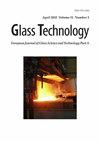Determinants of Technology Adoption and Intensity of Adoption among Rice Farming Households in Ogun State, Nigeria.
IF 0.3
4区 材料科学
Q4 MATERIALS SCIENCE, CERAMICS
Glass Technology-European Journal of Glass Science and Technology Part a
Pub Date : 2022-09-12
DOI:10.47672/ejt.1187
引用次数: 0
Abstract
Purpose: Production and productivity of the agricultural sector in SSA is low due to low technological adoption and techniques among others. One of the major goals of Nigerian agriculture development programs and policies is transition from low productivity subsistence agriculture to a high productivity agro-industrial economy through improved technology adoption. Methodology: A multi-stage sampling technique was used in this study to select 158 rice farming households The first stage involved the purposive selection of two Agricultural Development programme zones (Ikenne and Abeokuta zones) in the state. The second stage was purposive selection of two blocks per zone based on the concentration of rice farmers. Six farming cells were randomly selected from each block making a total of twenty-four (24) farming community, seven rice farmers were randomly selected from each farming cell giving a sample size of 168 rice farmers. A set of structured questionnaires were used to collect data. Out of the 168-questionnaire administered 158 of it were gotten and used for the study. The data were analysed using descriptive statistics, adoption index, tobit regression model. Findings: Technologies adoption was high among the young farmers than the older farmers. The household size was also a determinant factor of technology adoption. As the household increases in size, there is high probability that all the production technologies will be adopted. Access to credit facility was found to be positive and significant in all the production technologies available to the rice farmers. Recommendations: It was recommended that the young people should be encouraged to modern technologies available for rice production, the farmers should be educated on modern technologies in the production of rice. Credit facilities should be made available for the farm household.尼日利亚奥贡州稻农家庭采用技术和采用强度的决定因素。
目的:由于低技术采用率和其他技术,SSA农业部门的生产和生产力较低。尼日利亚农业发展计划和政策的主要目标之一是通过改进技术采用,从低生产率的自给农业向高生产率的农业工业经济过渡。方法:本研究采用多阶段抽样技术,选择了158户水稻农户。第一阶段涉及有目的地选择该州的两个农业发展计划区(Ikenne和Abeokuta区)。第二阶段是根据稻农的集中程度,有目的地选择每个区两个街区。每个小区随机抽取6个小区,共24个小区,每个小区随机抽取7名稻农,总样本量为168名稻农。我们使用了一套结构化问卷来收集数据。在发放的168份问卷中,有158份被用于研究。采用描述性统计、采用指数、tobit回归模型对数据进行分析。研究发现:青年农民的技术采用率高于老年农民。家庭规模也是技术采用的决定因素。随着家庭规模的扩大,所有生产技术都被采用的可能性很大。研究发现,获得信贷便利对稻农可获得的所有生产技术都是积极和重要的。建议:建议应鼓励年轻人学习现代水稻生产技术,并对农民进行现代水稻生产技术的教育。应向农户提供信贷便利。
本文章由计算机程序翻译,如有差异,请以英文原文为准。
求助全文
约1分钟内获得全文
求助全文
来源期刊
CiteScore
0.30
自引率
0.00%
发文量
0
审稿时长
>12 weeks
期刊介绍:
The Journal of the Society of Glass Technology was published between 1917 and 1959. There were four or six issues per year depending on economic circumstances of the Society and the country. Each issue contains Proceedings, Transactions, Abstracts, News and Reviews, and Advertisements, all thesesections were numbered separately. The bound volumes collected these pages into separate sections, dropping the adverts. There is a list of Council members and Officers of the Society and earlier volumes also had lists of personal and company members.
JSGT was divided into Part A Glass Technology and Part B Physics and Chemistry of Glasses in 1960.

 求助内容:
求助内容: 应助结果提醒方式:
应助结果提醒方式:


